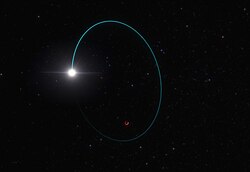Gaia BH3
| Observation data J2000
| ||
|---|---|---|
| Constellation | Aquila | |
| Right ascension | 19h 39m 18.71s[1] | |
| Declination | +14° 55′ 54.01″[1] | |
| Characteristics | ||
| Star | ||
| Evolutionary stage | Giant star | |
| Spectral type | G | |
| Black hole | ||
| Evolutionary stage | Stellar black hole | |
Argument of periastron (ω)(secondary) | 77.34 ±0.76° | |
| Details dex | ||
| Black hole | ||
| Mass | 32.70±0.82 M☉ | |
Gaia DR3 4318465066420528000, LS II +14 13 | ||
| Database references | ||
| SIMBAD | data | |
Gaia BH3 (Gaia DR3 4318465066420528000) is a
light years away (590.6±5.8 pc away) in the constellation of Aquila. Gaia BH3 is the first black hole discovered from preliminary Gaia DR4 astrometric data.[2]
The black hole and star orbit the system
barycentre every 11.6 years, with an orbital distance ranging from 4.5–29 AU.[3] The black hole's mass is 32.70 M☉
, the heaviest known stellar black hole in the Milky Way.
The black hole Gaia BH3 is together with
gravitational waves. These massive black holes were suspected to be formed by metal-poor stars and the fact that Gaia BH3 has a metal-poor companion strengthens this conclusion.[2]
Gaia BH3 was found to be part of a disrupted star cluster of low mass and this star cluster is today a halo stellar stream, called ED-2. This stellar stream is very old, with an age comparable to the globular cluster Messier 92. This means that Gaia BH3 likely formed more than 13 billion years ago and the black hole might have formed via direct collapse of a massive star. Alternatively the black hole could have formed via binary interaction inside the star cluster. The ED-2 star cluster has a mass between 2,000 M☉ and 42,000 M☉.[4]
Discovery
Gaia BH3 was identified in
References
- ^ a b "LS II +14 13". SIMBAD. Centre de données astronomiques de Strasbourg.
- ^ .
- ^ Dunham, Will (April 16, 2024). "Astronomers detect Milky Way's second-largest known black hole". Reuters.
- arXiv:2404.11604 [astro-ph.GA].
- ^ "Most massive stellar black hole in our galaxy found". European Southern Observatory. 16 April 2024. Archived from the original on 16 April 2024.

